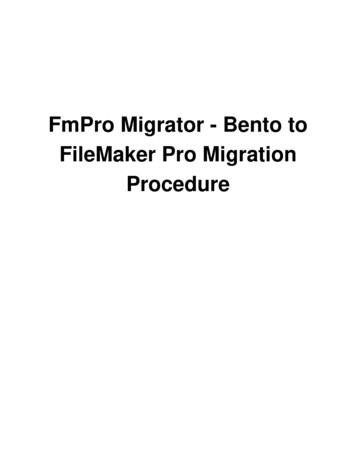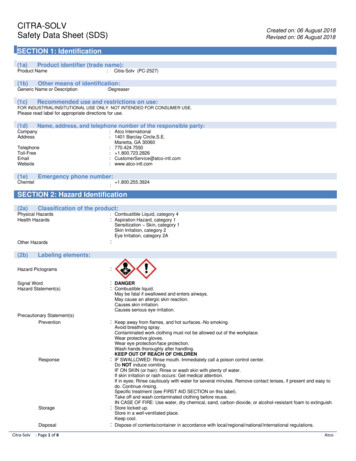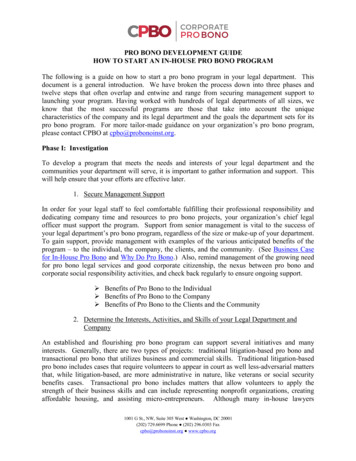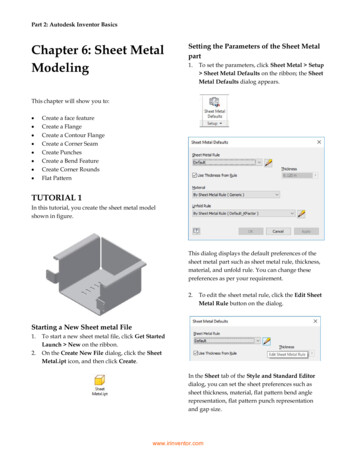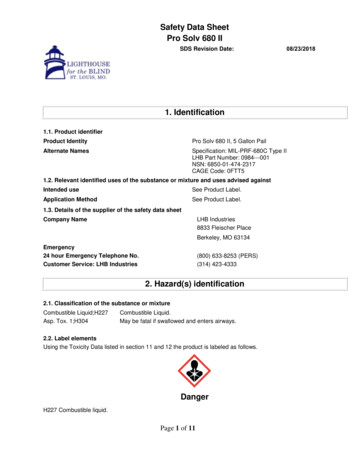
Transcription
Safety Data SheetPro Solv 680 IISDS Revision Date:08/23/20181. Identification1.1. Product identifierProduct IdentityPro Solv 680 II, 5 Gallon PailAlternate NamesSpecification: MIL-PRF-680C Type IILHB Part Number: 0984---001NSN: 6850-01-474-2317CAGE Code: 0FTT51.2. Relevant identified uses of the substance or mixture and uses advised againstIntended useSee Product Label.Application MethodSee Product Label.1.3. Details of the supplier of the safety data sheetCompany NameLHB Industries8833 Fleischer PlaceBerkeley, MO 63134Emergency24 hour Emergency Telephone No.Customer Service: LHB Industries(800) 633-8253 (PERS)(314) 423-43332. Hazard(s) identification2.1. Classification of the substance or mixtureCombustible Liquid;H227Asp. Tox. 1;H304Combustible Liquid.May be fatal if swallowed and enters airways.2.2. Label elementsUsing the Toxicity Data listed in section 11 and 12 the product is labeled as follows.DangerH227 Combustible liquid.Page 1 of 11
Safety Data SheetPro Solv 680 II08/23/2018SDS Revision Date:H304 May be fatal if swallowed and enters airways.[Prevention]:P210 Keep away from heat / sparks / open flames / hot surfaces - No smoking.P260 Do not breathe mist / vapors / spray.P262 Do not get in eyes, on skin, or on clothing.P280 Wear protective gloves / eye protection / face protection.[Response]:P301 310 IF SWALLOWED: Immediately call a POISON CENTER or doctor / physician.P331 Do NOT induce vomiting.[Storage]:P403 235 Store in a well ventilated place. Keep cool.P405 Store locked up.[Disposal]:P501 Dispose of contents / container in accordance with local / national regulations.3. Composition/information on ingredientsThis product contains the following substances that present a hazard within the meaning of the relevant State andFederal Hazardous Substances regulations.Ingredient/Chemical DesignationsWeight %Hydrotreated heavy naphtha (petroleum)CAS Number: 0064742-48-9100GHS ClassificationAsp. Tox. 1;H304Notes[1][1] Substance classified with a health or environmental hazard.[2] Substance with a workplace exposure limit.[3] PBT-substance or vPvB-substance.*The full texts of the phrases are shown in Section 16.4. First aid measures4.1. Description of first aid measuresGeneralInhalationEyesIn all cases of doubt, or when symptoms persist, seek medical attention.Never give anything by mouth to an unconscious person. If ingested, material may beaspirated into the lungs and cause chemical pneumonitis. Treat appropriately.Remove to fresh air, keep patient warm and at rest. If breathing is irregular or stopped, giveartificial respiration. If unconscious place in the recovery position and obtain immediatemedical attention. Give nothing by mouth.Irrigate copiously with clean water for at least 15 minutes, holding the eyelids apart andseek medical attention.Page 2 of 11
Safety Data SheetPro Solv 680 IISDS Revision Date:SkinIngestion08/23/2018Remove contaminated clothing. Wash skin thoroughly with soap and water or use arecognized skin cleanser.If swallowed obtain immediate medical attention. Keep at rest. Do NOT induce vomiting.4.2. Most important symptoms and effects, both acute and delayedOverviewPotential Physical/Chemical Effects:Combustible. Material can release vapors that readily form flammable mixtures. Vaporaccumulation could flash and/or explode if ignited. Material can accumulate static chargeswhich may cause an ignition.Potential Health Effects:Repeated exposure may cause skin dryness or cracking. If swallowed, may be aspiratedand cause lung damage. may be irritating to the eyes, nose, throat, and lungs.Note: This material should not be used for any other purpose than the intended use inSection 1 without expert advice. Health studies have shown that chemical exposure maycause potential human health risks which may vary from person to person.Exposure to solvent vapor concentrations from the component solvents in excess of thestated occupational exposure limits may result in adverse health effects such as mucousmembrane and respiratory system irritation and adverse effects on the kidneys, liver andcentral nervous system. Symptoms include headache, nausea, dizziness, fatigue, muscularweakness, drowsiness and in extreme cases, loss of consciousness.Repeated or prolonged contact with the preparation may cause removal of natural fat fromthe skin resulting in dryness, irritation and possible non-allergic contact dermatitis. Solventsmay also be absorbed through the skin. Splashes of liquid in the eyes may cause irritationand soreness with possible reversible damage. See section 2 for further details.5. Fire-fighting measures5.1. Extinguishing mediaDry chemical, foam, carbon dioxide and water fog.5.2. Special hazards arising from the substance or mixtureHazardous decomposition: Hazardous Combustion Products: Smoke, Fume, Incomplete Combustion products,Oxides of carbon, Flammable hydrocarbonsKeep away from heat / sparks / open flames / hot surfaces - No smoking.Do not breathe mist / vapors / spray.Do not get in eyes, on skin, or on clothing.5.3. Advice for fire-fightersDo not use straight streams of water.Page 3 of 11
Safety Data SheetPro Solv 680 IISDS Revision Date:08/23/2018Evacuate area. Prevent runoff from fire control or dilution from entering streams, sewers, or drinking water supply.Firefighters should use standard protective equipment and in enclosed spaces, self-contained breathing apparatus(SCBA). Use water spray to cool fire exposed surfaces and to protect personnel.Unusual Fire Hazards: Combustible.ERG Guide No.1286. Accidental release measures6.1. Personal precautions, protective equipment and emergency proceduresPut on appropriate personal protective equipment (see section 8).6.2. Environmental precautionsLarge Spills: Dike far ahead of liquid spill for later recovery and disposal. Prevent entry into waterways, sewers,basements or confined areas.Use good personal hygiene practices. Wash hands before eating, drinking, smoking or using toilet. Promptly removesoiled clothing and wash thoroughly before reuse.6.3. Methods and material for containment and cleaning upSpill Management:Land Spill: Eliminate all ignition sources (no smoking, flares, sparks or flames in immediate area). Stop leak if you cando it without risk. All equipment used when handling the product must be grounded. Do not touch or walk throughspilled material. Prevent entry into waterways, sewers, basements or confined areas. A vapor suppressing foam maybe used to reduce vapors. Use clean, non-sparking tools to collect absorbed material. Absorb or cover with dry earth,sand or other non-combustible material and transfer to containers.Large Spills: Water spray may reduce vapor, but may not prevent ignition in closed spaces. Recover by pumping orwith suitable absorbent.Water Spill: Stop leak if you can do it without risk. Remove from the surface by skimming or with suitable absorbents.Seek the advice of a specialist before using dispersants.Water spill and land spill recommendations are based on the most likely spill scenario for this material, however,geographic conditions, wind, temperature, (and in the case of a water spill) wave and current direction and speedmay greatly influence the appropriate action to be taken. For this reason, local experts should be consulted. Note:Local regulations may prescribe or limit action to be taken.Notification Procedures:In the event of a spill or accidental release, notify relevant authorities in accordance with all applicable regulations.US regulations require reporting releases of this material to the environment which exceed the applicable reportablequantity or oil spill which could reach any waterway including intermittent dry creeks. The National Response Centercan be reached at (800) 424-8802.Protective Measures:Avoid contact with spilled material. Warn or evacuate occupants in surrounding downwind area if required due totoxicity or flammability of the material. See Section 5 for fire fighting information. See the Hazard Identification Sectionfor Significant Hazards. See Section 4 for First Aid Advice. See Section 8 for advice on the minimum requirements forPage 4 of 11
Safety Data SheetPro Solv 680 IISDS Revision Date:08/23/2018personal protective equipment. Additional protective measures may be necessary, depending on the specificcircumstances and/or the expert judgement of the emergency responders.7. Handling and storage7.1. Precautions for safe handlingHandling: Avoid contact with skin. Prevent small spills and leakage to avoid slip hazard. Material can accumulatestatic charges which may cause an electrical spark (ignition source). When the material is handled in bulk, anelectrical spark could ignite any flammable vapors from liquid or residues that may be present (e.g., during switchloading operations). Use proper bonding and/or ground procedures. However, bonding and grounds may noteliminate the hazard from static accumulation. Consult local applicable standards for guidance.Loading/Unloading Temperature: [Ambient]Transport Temperature: [Ambient]Transport Pressure: [Ambient]Static Accumulator: This material is a static accumulator. A liquid is typically considered a nonconductive, staticaccumulator if its conductivity is below 100 pS/m (100x10E-12 Siemens per meter) and is considered a semiconductive, static accumulator if its conductivity is below 10,000 pS/m. Whether a liquid is nonconductive or semiconductive. the precautions are the same. A number of factors, for example liquid temperature, presence ofcontaminants, anti-static additives and filtration can greatly influence the conductivity of a liquid.See section 2 for further details. - [Prevention]:7.2. Conditions for safe storage, including any incompatibilitiesHandle containers carefully to prevent damage and spillage.Store in a cool dry area, away from heat, sparks and open flame. Keep containers sealed when not in use. Store outof direct sunlight.Incompatible materials: Strong oxidizing agentsStorage: The container choice, for example storage vessel, may effect static accumulation and dissipation. Keepcontainer closed. Handle containers with care. Open slowly in order to control possible pressure release. Store in acool, well-ventilated area. Storage containers should be grounded and bonded. Fixed storage containers, transfercontainers and associated equipment should be grounded and bonded to prevent accumulation of static charge.Storage Temperature: [Ambient]Storage Pressure: [Ambient]Suitable Containers/Packing: Tankers, tank trucks, railcars, barges, drums.Suitable Materials and Coatings (Chemical Compatibility): Inorganic zinc coatings, epoxy phenolics, teflon, neoprene,stainless steel, carbon steel.Unsuitable Materials and Coatings: Vinyl coatings, natural rubber, butyl rubber, ethylene-proplyene-diene monomer(EPDM).See section 2 for further details. - [Storage]:Page 5 of 11
Safety Data SheetPro Solv 680 II08/23/2018SDS Revision Date:7.3. Specific end use(s)No data available.8. Exposure controls and personal protection8.1. Control parametersExposureCAS No.0064742-48-9IngredientSourceHydrotreated heavy naphtha (petroleum)ValueOSHANo Established LimitACGIHNo Established LimitNIOSHNo Established LimitSupplierNo Established LimitCarcinogen DataCAS No.0064742-48-9IngredientHydrotreated heavy naphtha(petroleum)SourceValueOSHASelect Carcinogen: NoNTPKnown: No; Suspected: NoIARCGroup 1: No; Group 2a: No; Group 2b: No; Group 3: No; Group 4: No;8.2. Exposure controlsRespiratoryIf workers are exposed to concentrations above the exposure limit they must use theappropriate, certified respirators.EyesProtective safety glasses recommendedSkinEngineering ControlsOther Work PracticesChemical resistant clothing such as coveralls/apron and boots should be worn. Wearchemical resistant gloves. Consult the glove/clothing manufacturer to determine theappropriate type glove/clothing for a given application.Provide adequate ventilation. Where reasonably practicable this should be achieved by theuse of local exhaust ventilation and good general extraction. If these are not sufficient tomaintain concentrations of particulates and any vapor below occupational exposure limitssuitable respiratory protection must be worn.Use good personal hygiene practices. Wash hands before eating, drinking, smoking orusing toilet. Promptly remove soiled clothing and wash thoroughly before reuse.See section 2 for further details. - [Prevention]:Page 6 of 11
Safety Data SheetPro Solv 680 IISDS Revision Date:08/23/20189. Physical and chemical propertiesAppearanceOdorOdor thresholdpHMelting point / freezing pointInitial boiling point and boiling rangeFlash PointEvaporation rate (Ether 1)Flammability (solid, gas)Upper/lower flammability or explosive limitsVapor pressure (Pa)Vapor DensitySpecific GravitySolubility in WaterPartition coefficient n-octanol/water (Log Kow)Auto-ignition temperatureDecomposition temperatureViscosity (cSt)Relative DensityDensityPour pointCoefficient of thermal expansionMolecular WeightClear LiquidOdorlessNot MeasuredNot MeasuredNot Measured185C (365F) - 211C (412F) 61C (142F) [ASTM D-93] 0.1Not ApplicableLower Explosive Limit: 0.7Upper Explosive Limit: 5.30.064 kPa (0.48 mm Hg) at 20C 0.13 kPa (0.98 mm Hg)at 38C 0.28 kPa (2.1 mm Hg) at 50C5.6 at 101 kPaNot MeasuredNegligibleNot Measured335C (635F)Not Measured1.55 cSt (1.55 mm2/sec) at 40C 1.99 cSt (1.99mm2/sec) at 25C0.767 at 15C769 kg/m3 (6.42 lbs/gal, 0.77 kg/dm3)-57C (-71F)0.00078 V/VDEGC1639.2. Other informationNo other relevant information.10. Stability and reactivity10.1. ReactivityHazardous Polymerization will not occur.Page 7 of 11
Safety Data SheetPro Solv 680 II08/23/2018SDS Revision Date:10.2. Chemical stabilityStable under normal circumstances.10.3. Possibility of hazardous reactionsNo data available.10.4. Conditions to avoidExcessive heat and open flame.10.5. Incompatible materialsStrong oxidizing agents10.6. Hazardous decomposition productsHazardous Comubstion Products: Smoke, Fume, Incomplete Combustion products, Oxides of carbon, Flammablehydrocarbons11. Toxicological informationAcute toxicityExposure to solvent vapor concentrations from the component solvents in excess of the stated occupational exposurelimits may result in adverse health effects such as mucous membrane and respiratory system irritation and adverseeffects on the kidneys, liver and central nervous system. Symptoms include headache, nausea, dizziness, fatigue,muscular weakness, drowsiness and in extreme cases, loss of consciousness.Repeated or prolonged contact with the preparation may cause removal of natural fat from the skin resulting indryness, irritation and possible non-allergic contact dermatitis. Solvents may also be absorbed through the skin.Splashes of liquid in the eyes may cause irritation and soreness with possible reversible damage.IngredientHydrotreated heavy naphtha (petroleum) - (64742-48-9)Oral LD50,mg/kg5,000.00, Rat Category: 5Skin LD50,mg/kgInhalationVapor LD50,mg/L/4hr3,160.00,Rabbit Category: 5No dataavailableInhalationDust/Mist LD50,mg/L/4hrNo dataavailableNote: When no route specific LD50 data is available for an acute toxin, the converted acute toxicity pointestimate was used in the calculation of the product's ATE (Acute Toxicity Estimate).ClassificationCategoryHazard DescriptionAcute toxicity (oral)---Not ApplicableAcute toxicity (dermal)---Not ApplicableAcute toxicity (inhalation)---Not ApplicableSkin corrosion/irritation---Not ApplicableSerious eye damage/irritation---Not ApplicableRespiratory sensitization---Not ApplicablePage 8 of 11InhalationGas LD50,ppmNo dataavailable
Safety Data SheetPro Solv 680 IISDS Revision Date:08/23/2018Skin sensitization---Not ApplicableGerm cell mutagenicity---Not ApplicableCarcinogenicity---Not ApplicableReproductive toxicity---Not ApplicableSTOT-single exposure---Not ApplicableSTOT-repeated exposure---Not ApplicableAspiration hazard1May be fatal if swallowed and enters airways.12. Ecological information12.1. ToxicityToxic to aquatic lifeAquatic Ecotoxicity96 hr LC50 fish,mg/l48 hr EC50 crustacea,mg/l2,200.00, Pimephalespromelas2.60, ChaetogammarusmarinusIngredientHydrotreated heavy naphtha (petroleum) - (64742-48-9)12.2. Persistence and degradabilityThere is no data available on the preparation itself.12.3. Bioaccumulative potentialNot Measured12.4. Mobility in soilNo data available.12.5. Results of PBT and vPvB assessmentThis product contains no PBT/vPvB chemicals.12.6. Other adverse effectsNo data available.13. Disposal considerations13.1. Waste treatment methodsObserve all federal, state and local regulations when disposing of this substance.Page 9 of 11ErC50 algae,mg/lNot Available
Safety Data SheetPro Solv 680 IISDS Revision Date:08/23/201814. Transport information14.1. UN number14.2. UN proper shippingname14.3. Transport hazardclass(es)14.4. Packing groupDOT (Domestic SurfaceTransportation)Not RegulatedIMO / IMDG (OceanTransportation)Not RegulatedICAO/IATANot Regulated14.5. Environmental hazardsIMDGMarine Pollutant: No14.6. Special precautions for userNo further information15. Regulatory informationRegulatory OverviewToxic SubstanceControl Act ( TSCA)WHMIS ClassificationUS EPA Tier II HazardsThe regulatory data in Section 15 is not intended to be all-inclusive, only selectedregulations are represented.All components of this material are either listed or exempt from listing on the TSCAInventory.B3Fire:Sudden Release of Pressure:Reactive:Immediate (Acute):Delayed (Chronic):YesNoNoNoNoEPCRA 311/312 Chemicals and RQs:To the best of our knowledge, there are no chemicals at levels which require reporting under this statute.EPCRA 302 Extremely Hazardous:To the best of our knowledge, there are no chemicals at levels which require reporting under this statute.EPCRA 313 Toxic Chemicals:To the best of our knowledge, there are no chemicals at levels which require reporting under this statute.Proposition 65 - Carcinogens ( 0.0%):To the best of our knowledge, there are no chemicals at levels which require reporting under this statute.Proposition 65 - Developmental Toxins ( 0.0%):To the best of our knowledge, there are no chemicals at levels which require reporting under this statute.Page 10 of 11
Safety Data SheetPro Solv 680 IISDS Revision Date:08/23/2018Proposition 65 - Female Repro Toxins ( 0.0%):To the best of our knowledge, there are no chemicals at levels which require reporting under this statute.Proposition 65 - Male Repro Toxins ( 0.0%):To the best of our knowledge, there are no chemicals at levels which require reporting under this statute.New Jersey RTK Substances ( 1%) :To the best of our knowledge, there are no chemicals at levels which require reporting under this statute.Pennsylvania RTK Substances ( 1%) :To the best of our knowledge, there are no chemicals at levels which require reporting under this statute.16. Other informationThe information and recommendations contained herein are based upon data believed to be correct. However, noguarantee or warranty of any kind, expressed or implied, is made with respect to the information contained herein.We accept no responsibility and disclaim all liability for any harmful effects which may be caused by exposure to ourproducts. Customers/users of this product must comply with all applicable health and safety laws, regulations, andorders.The full text of the phrases appearing in section 3 is:H304 May be fatal if swallowed and enters airways.This is the first version in the GHS SDS format. Listings of changes from previous versions in other formatsare not applicable.IMPORTANT NOTE: This information is furnished without warranty, expressed or implied, as to accuracy orcompleteness. The information is obtained from various sources including the manufacturer and other third partysources. The information may not be valid under all conditions nor if this material is used in combination with othermaterials or any process. Final determination of suitability of any material is the sole responsibility of the user.End of DocumentPage 11 of 11
Pro Solv 680 II SDS Revision Date: 08/23/2018 Page 1 of 11. 1. Identification. 1.1. Product identifier Product Identity . Pro Solv 680 II, 5 Gallon Pail . Alternate Names . Specification: MIL-PRF-680C Type II LHB Part Number: 0984---001 NSN: 6850-01-474-2317 . CAGE Code: 0FTT5 . 1.2. Relevant identified uses of the substance or mixture and uses .

